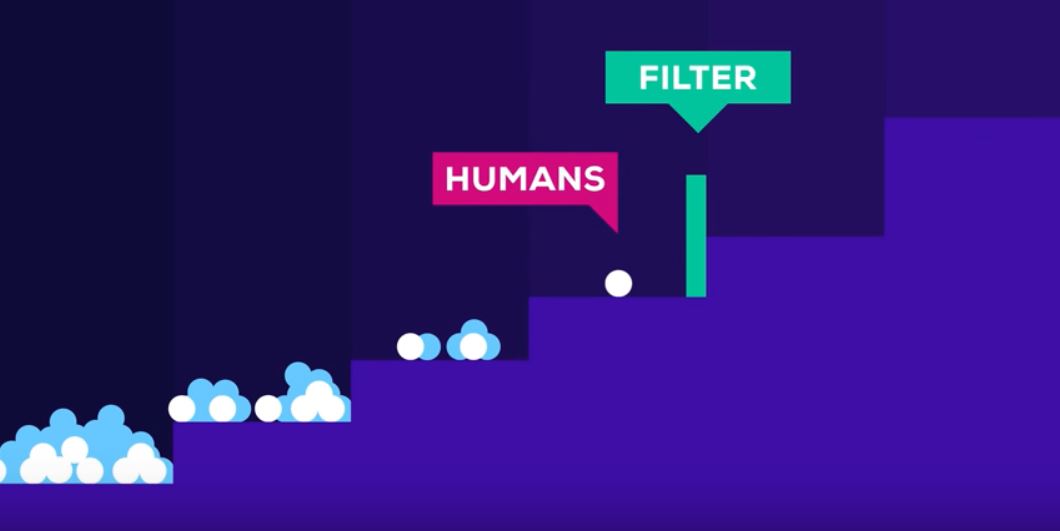The Great Filter of Learning Japanese and Some Numbers to Cheer you Up
When you get caught up in the struggle of mastering Japanese, it’s easy to think you aren’t doing well. Your efforts are failing. You are going slow. You are doing something wrong. Others are just doing it better. But you probably have come way further than most people, and taking a look at the numbers may reveal some positive news for you.
**Warning**: numbers that don’t contain a resource link are very loose estimates based on various assumptions I’m making. They may be completely wrong. This was written for fun and I’m sure a bunch of holes can be poked into the logic :)
How many people are interested in Japan and Japanese stuff?
Japan had around 32,000,000 international tourists in 2019. An interest in manga and anime probably also shows an interest in Japan, and according to some broad analytics of anime and manga, there are at least 20-30 million fans of these (though I would assume this number may overlap some with the tourist number).
People who are interested in Japan and Japanese stuff: 50,000,000
How many people want to study Japanese?
Liking Japanese stuff doesn’t necessarily mean you want to study Japanese. But I would think around 20% eventually develop the desire to. This is going to be the base number, with all percentages below working off of it.
People who want to study Japanese: 10,000,000
How many people are studying Japanese?
The progression from wanting to study Japanese and actually studying Japanese is a big deal. Which is why if you have already made the effort to start, you need to give yourself an early pat on the back.
It’s easy to get scared away by the complexity, the image of an impossible language, and the fear of being inadequate or looking stupid. My freshman year of college I wanted to study Japanese. It took me almost 4 years to gain the confidence to start.
Several years back, an academic survey revealed around 4 million people were studying Japanese. This number isn’t really accurate because it doesn’t include the self learners who never attend any kind of academic studying. Also, the numbers have been trending upwards and it’s been almost a decade since the study. I’m going to add an extra million to that figure. 50% of people who want to study Japanese actually attempt to do so.
People who actually attempt to study Japanese: 5,000,000
How many people make it past beginner
5,000,000 people study Japanese. That doesn’t say much because that means you might have taken one class, or opened one textbook and then stopped there. Trying to figure out how many people make it past beginner can be worked with a little bit of help from some JLPT figures.
In 2018, there were around 1,000,000 test takers. The numbers have steadily risen every year, and since the July test takers of 2019 was around 550,000 (up from 470k in 2018), I’m going to assume the number is closer to 1.15 million for 2019. That means around 22% of learners take the JLPT (very close to what I said 9 years ago!)
Assumption: if you take the JLPT, you probably made it past beginner level. But what about all the people that take the easiest level (N5)? Wouldn’t that skew things a bit? Surprisingly N5 test takers are in the minority.
In 2018, of the 1,009,074 that took the test, the breakdown of levels is as follows:
N5: 105,033 -> 10.5%
N4: 135,695 -> 13.5%
N3: 244,077 -> 24.1%
N2: 304,238 -> 30.1%
N1: 220,031 -> 21.8%
Random fun fact
Most Japanese learners in Japan don’t take N5 or N4. Maybe because it doesn’t have the career/visa boost that N1 or N2 has. Or maybe because there are just more higher level learners living in Japan.
Japan (2018)
N5: 6,760
N4: 36,218
N3: 120,753
N2: 120,819
N1: 80,380
Overseas (2018)
N5: 98,273
N4: 99,477
N3: 123,324
N2: 183,419
N1: 139,651
Random motivating fact
In 2018, 1,009,074 may have taken the exam, but 1,168,000 people applied for it. Which means that 158,926 or 13% of people dropped out. While part of this number accounts for illness, injury, and other life situations, I would assume other people couldn’t go through with it. So if you actually sat for the test, regardless of how you did, you stared something scary right in the face and fought back.
How many post-beginners?
I kind of went off on a tangent there, but out of the 1,000,000 people sitting for the exam, only around 35% actually pass. However, just because you didn’t pass doesn’t mean you aren’t higher than beginner, and there are still all the other non-test takers to account for.
Considering all of the above, with my own personal observations of Jalup users over the past decade, I think around 10% of people who want to study Japanese make it past beginner.
People who get past beginner: 1,000,000
How many people go beyond Intermediate?
For anyone who has ever seen the transition of a beginner college course with 20-30 people to an intermediate course of 5-10 people, you know big changes happen here. Intermediate level is the great filter.
The Great Filter in science is a theory why there aren’t any super advanced alien races running around our galaxy trying to make contact with us (or destroy us). The theory also ponders the ultimate fate of humanity.
As life forms continue to evolve and advance, there reaches a breaking point (series of breaking points) that will either cause the life form to be destroyed (or destroy itself), or achieve advanced civilization status. The big question is whether humans are before the filter (signaling our impending doom), or if we already have passed it, making us ridiculously special and on our way to supreme status.

I like to think of Intermediate level as the great filter of Japanese learners. It causes the fiery death of many, but those that overcome it usually are well on their way to fluency. 4% of those who want to study Japanese make it past intermediate.
People who get past intermediate: 400,000
How many people make it past advanced level and get to fluency
While you’d think you are in the clear, many people still get stuck at the higher levels, and never reach fluency. This is the high-level blues. 1% of people who want to study Japanese make it to the finish line.
People who get to fluency: 100,000
This number feels about right. In 2018, 68,506 passed N1. That doesn’t mean fluency though, but there are all the other people who never take the JLPT that add to this.
What am I trying to say?
No matter how far you’ve come, you’ve overcome many obstacles that others couldn’t before you. Take a moment to realize that you are already achieving good things even if you aren’t exactly where you want to be just yet.
Founder of Jalup. iOS Software Engineer. Former attorney, translator, and interpreter. Still watching 月曜から夜ふかし weekly since 2013.





Great article for motivation. I have found myself doing this more informally in my head before to keep me motivated. Sometimes I will think to myself “how many people have even made it to jalup ______”. I think it is important to play mental games with yourself to keep your motivation and confidence up.
It’s easy to forget, yet so important to remember what you actually have accomplished already.
Somewhat motivating but also somewhat depressing as thinking I could easily be one of the intermediate learners who doesn’t make it past. After all I’m sure many of them were very hardworking too and why should I be any better than the ones who didn’t make it past?
I’m making a push this year to finish the first 5000 of your cards (660 to go) to add to the 850 other J-J cards I have in my deck from tutoring sessions) Still frustrated by how poor my abilities are and feeling that after a few years Anki has become a grind so I’m not adding any new tutoring cards. After I finish your 5000 cards I won’t add anything new. I’ll continue daily reviews and hope as the reviews go down and do more immersion I can make it over the hump and post as a success study here in a few years.
You’ll make it Greg. I’ve seen you work hard here for a long time, and you haven’t stopped yet. That shows me that you’ll keep going.
The great intermediate filter isn’t about natural talent. It’s about whether you can keep moving forward despite hitting a confidence-busting plateau.
Don‘t worry too much you will make it. Of course many people work hard and don’t make it but the activity of learning japanese is not the main battle that decides if you make it or not. The main battle is the emotional battle between your dreams and goals against your doubts.
Even if you dont add new cards your old cards will get so much stronger over time it souldn‘t be underestimated.
There are many levels for each card from only understanding it when seeing it in anki to Understanding it when you see it in the wild without any concentration. But as long as you keep up your immersion and your anki reviews I guarantee you you will reach that level for a lot of the cards in your anki deck and that will get you over the intermediate hump or even further.
As someone who was at the mid level blues for 5-7 years. Let me tell you you can make it as well. and it was more than worth it.
A key factor as with anything is how badly you want it. If you desperately want fluency, you will get there. Do a ton of immersion a day if possible and a few cards and you’ll reach your goal as long as you are consistent and don’t miss days.
If it helps you any, I stopped for 7 months (don’t do this lol) to learn Spanish with this kind of method and by the end I was getting very close to fluent listening and reading. It gave me perspective and a massive motivation boost because I knew first hand that it works. Since coming back to Japanese my progress feels much quicker! (Probably because, unlike before, I’m doing much more active immersion and far fewer anki cards and just looking up what interests me as I go). This way there’s no burnout chance.
You can do this. It’s all mental games. Everytime you hear in your head that you are going to slowly or…will this really work, ignore it. It’s a waste of time and your enemy. As long as you’re getting tons of active immersion (2 hours minimum? I’d say 4-5 if possible) per day and also plenty of semi-active/passive and are adding a new cards this WILL happen.
If you’ve already done thousands of cards it may be a good idea to pause for a little bit and just review and immerse.
Also, enjoyment is key and will become much easier as you get better.
Sorry if what I said sounded forceful at all, I just wish to help you stay motivated.
I hope it all works out for you!
No this this great advice, thanks for sharing. My biggest immersion worry is picking things that are level appropriate that I understand enough and it benefits me. Any specific advice on that?
The more words you don’t understand in your immersion, the more chances to learn something new. If you understand 90 percent, only 10 percent has something to learn (except nuances). If you understand 40 percent, you have 60 percent of the material to learn a lot more new things. Of course, there’s the “context” side of things, but that’s why you semi active immerse in what you’ve already seen. I’d say just immerse in what interests you most. But on the other hand, I think slice of life anime or dramas are probably best for a while so that you are hearing more natural speech and you are drilling grammar patterns into your brain. (Because they are simpler so you aren’t focusing so much on vocab and more on patterns and grammar).That’s for semi active/ passive though. Watch what interests you for active.
Finally, I dont think you should worry about the difficulty level. I remember listening to sword art online back in the day and it being really hard, but over time I understood more and more until it became much easier. It was “above my level”.
Thanks for the encouraging words. I did study Spanish before Japanese and got to an okay level (could have 10-20 minute conversations when traveling in South America) before switching to Japanese. I was thinking if it put the same amount of time into Spanish I’d probably be fluent by now. Not giving up on Japanese but would eventually like to know both Japanese and Spanish so if my Japanese gets better in 1-2 years will add back some Spanish study.
It reminds me when I took a Japanese language course at college. I think like two thirds of the class ended up dropping out. It was just a semester long class at introduction level.